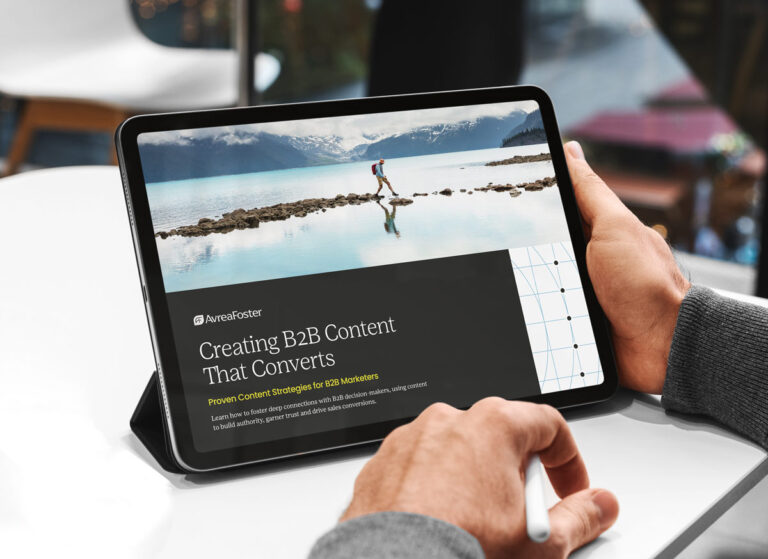Content is king. It’s a phrase that’s been in the marketing lexicon for a few decades now and, while it is true, it also causes some B2B brands to jump the gun with content marketing. What I mean by that is it’s not uncommon to see businesses emphasize creating content marketing assets while neglecting their largest piece of digital content – their website.
Your website is more than scaffolding that supports a content marketing strategy; it is the foundation. As such, let’s lift the hood and make sure your website is firing on all cylinders before you set out on your B2B content marketing journey.
B2B Website User Experience & User Journey
An individual B2B content asset within your strategy is an entrée to your organization’s larger capabilities and differentiators, and your website is most often where prospective customers will expand their understanding of your offering. B2B websites are also living, breathing organisms that require upkeep, updates and ongoing maintenance to continue delivering valuable content at a high level. Despite this fact, we often see B2B websites that were launched 3-5+ years ago that have hardly been touched since; in the eyes of their owners, they’re still new.
So, is your B2B website’s content strategy successfully engaging and converting users? Is there a cohesive user journey? Is it responsive on mobile? How are your load times? If the answers make you queasy, or if you don’t know the answers at all, a website content audit and performance review is where you should start before you consider sharing content.
User Journey
While your website user gets to choose their own adventure, it’s up to you to provide the pathways. Rather than lay dozens of possible pages at the feet of your users, a conversion-focused B2B website should provide a few curated choices with thoughtful connectivity that allow visitors to navigate in a logical, engaging way until they reach a point where the only next step is reaching out to you.
If your website has an unusually high homepage bounce rate (B2B websites average around 56%) or if the tools you use to visualize user paths show little consistency, we recommend taking a step back and evaluating your user journey before proceeding with an inbound content strategy.
Mobile Responsiveness
Even by conservative estimates, 15-20% of B2B website traffic is from mobile devices. Chances are, that number is even higher for your website. With those numbers in mind, it’s clear that responsive website design is no longer something that can be ignored. Providing your users with a seamless experience, regardless of device or screen size, is great for B2B website engagement and it’s great for SEO.
If your B2B website isn’t delivering a high-quality user experience on mobile devices, you’ll likely be throwing good money after bad by promoting content without addressing that need.
Page Load Speed
While B2B sales cycles can be long and slow-moving, time is absolutely of the essence when it comes to B2B website load times. An example: 82% of B2B websites load in under 5 seconds, but a B2B website that loads in 1 second converts at 3 times the rate of one that loads in 5 seconds and at 5 times the rate of one that loads in 10 seconds.
There are enough factors that inform load time and ways to improve load time to fill another blog post — from minifying code to optimizing images and beyond. For now, audit your load times and, if they come in over that 5-second mark, look to make improvements before launching your B2B content marketing strategy.

Search Engine Optimization (SEO)
Search engine optimization (SEO) is the long game every B2B website has to play in order to be found by the right target audience when they’re actively searching for help. In fact, 66% of B2B buyers use search engines for product research. Organic search is also an arena of elevated competition, as first-results page real estate is a very limited resource and 29% of B2B searchers never make it past those initial results.
Properly serving search engines is also exceptionally important at the outset of a B2B content marketing strategy because it’s the wellspring of research and analytics that should be directly informing your new efforts. If your B2B website has poor SEO performance, that is often indicative of ineffective existing content and should be addressed before you create assets.
Keyword Research & Seed Keyword List
No matter how well you or a partner like AvreaFoster knows your industry, SEO is not a guessing game. Digging deep into keywords is key to understanding what your target audience thinks, researches and cares about. Ultimately, it is foundational if you want to increase organic traffic.
The output of this research is a top-level seed keyword list and topic-specific keyword lists that should inform the language used across your B2B website, in content assets, in digital ads, in social media posts and, essentially, anywhere you deploy digital tactics.
Without this information, you’re building your strategy on a shaky foundation of assumptions. In our experience, that does not correlate with success.
Internal Linking
Are your website pages individual silos of information or are they part of an interconnected content network? For both SEO and user experience improvement, we advise taking a holistic view of your B2B website content and identifying any opportunities to create new links between pages.
These links can be in the form of text hyperlinks or interactive buttons, but the bottom line is that this is low-hanging fruit that should be picked before kicking off your B2B content marketing campaigns.

Content Marketing Strategy Analytics
If you’re a marketing professional, you know how important it is to substantiate value and ladder up to KPIs. Before you roll out B2B content marketing campaigns, make sure your website is bolstered by multiple ways to measure engagement.
According to LinkedIn Collective, three of the top B2B marketing measurement challenges are measuring quality over quantity, collecting the right signals and measuring the entire journey. Don’t wait until after your B2B content marketing campaigns are live to discover where the holes are in your marketing measurement capabilities.
Tracking & User Data
Ensure a tool like Google Analytics is correctly set up on your B2B website, and then integrate it with your marketing platform of choice before launching anything. This will allow you to measure the success of your content marketing assets, follow users on their journey from content to website to conversion, and compare the results of the content audit with any A/B testing you conduct.
To ignore this step is to willingly fly blind, waiting for sales to credit marketing for lead generation. You could be waiting a while.
User Behavior Visualization
Through the integration of third-party tools, it’s possible to create heat mapping, scroll mapping and other visualized behavioral user data. This feedback can be vital to iterating on your content marketing strategy and your website content, since it adds valuable context to the empirical data provided through other dashboards.
Be careful, though, as the scripts behind some of these tools can be weighty — dragging down your page load speeds and resulting in a net negative impact on your success.
Need Help With Your B2B Content Strategy?
While this list of considerations may sound daunting, tuning up your B2B website with these suggestions will not only empower B2B content marketing efforts but also support content marketing success across all channels.
If you’d like the support of an expert digital content marketing agency, AvreaFoster is here to audit the current state of your website, create a roadmap to digital optimization, and craft a winning B2B content marketing strategy that thoughtfully builds your elevated website.



